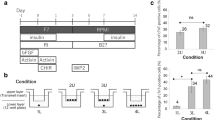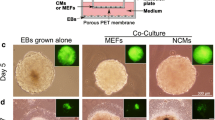Abstract
Leukemia inhibitory factor (LIF) is a growth factor with pleiotropic biological functions. It has been reported that LIF acts at different stages during mesoderm development. Also, it has been shown that LIF has a cytoprotective effect on neonatal murine cardiomyocytes (CMs) in culture, but little is known about the role of LIF during human cardiogenesis. Thus, we analyzed the effects of LIF on human pluripotent stem cells (PSC) undergoing cardiac differentiation. We first showed that LIF is expressed in the human heart during early development. We found that the addition of LIF within a precise time window during the in vitro differentiation process significantly increased CMs viability. This finding was associated to a decrease in the expression of pro-apoptotic protein Bax, which coincides with a reduction of the apoptotic rate. Therefore, the addition of LIF may represent a promising strategy for increasing CMs survival derived from PSCs.





Similar content being viewed by others
Change history
14 November 2017
Please note that Carolina Blüguermann’s surname was misspelled (as Blugüermann) in this article as originally published.
References
Taupin, J.L., Pitard, V., Dechanet, J., Miossec, V., Gualde, N., & Moreau, J.F. (1998). Leukemia inhibitory factor: part of a large ingathering family. International Reviews of Immunology, 16(3–4), 397–426.
Rathjen, P.D., Toth, S., Willis, A., Heath, J.K., & Smith, A.G. (1990). Differentiation inhibiting activity is produced in matrix-associated and diffusible forms that are generated by alternate promoter usage. Cell, 62(6), 1105–1114.
Godard, A., Heymann, D., Raher, S., Anegon, I., Peyrat, M.A., Le Mauff, B., et al. (1992). High and low affinity receptors for human interleukin for DA cells/leukemia inhibitory factor on human cells. Molecular characterization and cellular distribution. The Journal of Biological Chemistry, 267(5), 3214–3222.
Fischer, P., & Hilfiker-Kleiner, D. (2008). Role of gp130-mediated signalling pathways in the heart and its impact on potential therapeutic aspects. British Journal of Pharmacology, 153 Suppl 1, S414–S427.
Yoshida, K., Taga, T., Saito, M., Suematsu, S., Kumanogoh, A., Tanaka, T., et al. (1996). Targeted disruption of gp130, a common signal transducer for the interleukin 6 family of cytokines, leads to myocardial and hematological disorders. Proceedings of the National Academy of Sciences of the United States of America, 93 (1), 407–411.
Sheng, Z., Pennica, D., Wood, W.I., & Chien, K.R. (1996). Cardiotrophin-1 displays early expression in the murine heart tube and promotes cardiac myocyte survival. Development, 122(2), 419–428.
Conquet, F., Peyriéras, N, Tiret, L., & Brûlet, P. (1992). Inhibited gastrulation in mouse embryos overexpressing the leukemia inhibitory factor. Proceedings of the National Academy of Sciences of the United States of America, 89(17), 8195–8199.
Fujio, Y., Kunisada, K., Hirota, H., Yamauchi-Takihara, K., & Kishimoto, T. (1997). Signals through gp130 upregulate bcl-x gene expression via STAT1-binding cis-element in cardiac myocytes. The Journal of Clinical Investigation, 99(12), 2898–2905.
Kunisada, K., Tone, E., Fujio, Y., Matsui, H., Yamauchi-Takihara, K., & Kishimoto, T. (1998). Activation of gp130 transduces hypertrophic signals via STAT3 in cardiac myocytes. Circulation, 98(4), 346–352.
Nelson, S.K., Wong, G.H., & McCord, J.M. (1995). Leukemia inhibitory factor and tumor necrosis factor induce manganese superoxide dismutase and protect rabbit hearts from reperfusion injury. Journal of Molecular and Cellular Cardiology, 27(1), 223–229.
Yang, X., Cohen, M.V., & Downey, J.M. (2010). Mechanism of cardioprotection by early ischemic preconditioning. Cardiovascular Drugs and Therapy, 24(3), 225–234.
Van Vliet, P., Wu, S.M., Zaffran, S., & Pucéat, M. (2012). Early cardiac development: a view from stem cells to embryos. Cardiovascular Research, 96(3), 352–362.
Poon, E., Kong, C.W., & Li, R.A. (2011). Human pluripotent stem cell-based approaches for myocardial repair: from the electrophysiological perspective. Molecular Pharmaceutics, 8(5), 1495–1504.
Zou, Y., Takano, H., Mizukami, M., Akazawa, H., Qin, Y., Toko, H., et al. (2003). Leukemia inhibitory factor enhances survival of cardiomyocytes and induces regeneration of myocardium after myocardial infarction. Circulation, 108(6), 748–753.
Thomson, J.A., Itskovitz-Eldor, J., Shapiro, S.S., Waknitz, M.A., Swiergiel, J.J., Marshall, V.S., et al. (1998). Embryonic stem cell lines derived from human blastocysts. Science, 282(5391), 1145–1147.
Romorini, L., Scassa, M.E., Videla Richardson, G., Blüguermann, C, Jaquenod de Giusti, C., Questa, M., et al. (2012). Activation of apoptotic signalling events in human embryonic stem cells upon Coxsackievirus B3 infection. Apoptosis, 17(2), 132–142.
Scassa, M.E., Jaquenod de Giusti, C., Questa, M., Pretre, G., Richardson, G.A.V., Bluguermann, C., et al. (2011). Human embryonic stem cells and derived contractile embryoid bodies are susceptible to Coxsakievirus B infection and respond to interferon Ibeta treatment. Stem Cell Research, 6(1), 13–22.
García, C.P., Videla Richardson, G.A., Romorini, L., Miriuka, S.G., Sevlever, G.E., & Scassa, M.E. (2014). Topoisomerase I inhibitor, camptothecin, induces apoptogenic signaling in human embryonic stem cells. Stem Cell Research, 12(2), 400–414.
Wu, L., Bluguermann, C., Kyupelyan, L., Latour, B., Gonzalez, S., Shah, S., et al. (2013). Human developmental chondrogenesis as a basis for engineering chondrocytes from pluripotent stem cells. Stem Cell Reports, 1(6), 575–589.
Willems, E., Spiering, S., Davidovics, H., Lanier, M., Xia, Z., Dawson, M., et al. (2011). Small-molecule inhibitors of the Wnt pathway potently promote cardiomyocytes from human embryonic stem cell-derived mesoderm. Circulation Research, 109(4), 360–364.
Yang, L., Soonpaa, M.H., Adler, E.D., Roepke, T.K., Kattman, S.J., Kennedy, M., et al. (2008). Human cardiovascular progenitor cells develop from a KDR+ embryonic-stem-cell-derived population. Nature, 453 (7194), 524–528.
Vallier, L., Touboul, T., Chng, Z., Brimpari, M., Hannan, N., Millan, E., et al. (2009). Early cell fate decisions of human embryonic stem cells and mouse epiblast stem cells are controlled by the same signalling pathways. PLoS One, 4(6), e6082.
Lanier, M., Schade, D., Willems, E., Tsuda, M., Spiering, S., Kalisiak, J., et al. (2012). Wnt inhibition correlates with human embryonic stem cell cardiomyogenesis: a structure-activity relationship study based on inhibitors for the Wnt response. Journal of Medicinal Chemistry, 55(2), 697–708.
Bader, A., Gruss, A., Höllrigl, A, Al-Dubai, H., Capetanaki, Y., & Weitzer, G. (2001). Paracrine promotion of cardiomyogenesis in embryoid bodies by LIF modulated endoderm. Differentiation, 68(1), 31–43.
Lough, J., & Sugi, Y. (2000). Endoderm and heart development. Developmental Dynamics, 217(4), 327–342.
Wong, W.W.L., & Puthalakath, H. (2008). Bcl-2 family proteins: the sentinels of the mitochondrial apoptosis pathway. IUBMB Life, 60(6), 390–397.
Hirota, H., Chen, J., Betz, U.A., Rajewsky, K., Gu, Y., Ross, J Jr, et al. (1999). Loss of a gp130 cardiac muscle cell survival pathway is a critical event in the onset of heart failure during biomechanical stress. Cell, 97(2), 189–198.
Schust, J., Sperl, B., Hollis, A., Mayer, T.U., & Berg, T. (2006). Stattic: a small-molecule inhibitor of STAT3 activation and dimerization. Chemistry & Biology, 13(11), 1235–1242.
Passier, R., Denning, C., & Mummery, C. (2006). Cardiomyocytes from human embryonic stem cells. Handbook of Experimental Pharmacology, 174, 101–122.
Bader, A., Al-Dubai, H., & Weitzer, G. (2000). Leukemia inhibitory factor modulates cardiogenesis in embryoid bodies in opposite fashions. Circulation Research, 86(7), 787–794.
Grosset, C., Jazwiec, B., Taupin, J.L., Liu, H., Richard, S., Mahon, F.X., et al. (1995). In vitro biosynthesis of leukemia inhibitory factor/human interleukin for DA cells by human endothelial cells: differential regulation by interleukin-1 alpha and glucocorticoids. Blood, 86(10), 3763–3770.
Liu, X., Tseng, S.C.G., Zhang, M.C., Chen, S.Y., Tighe, S., Lu, W.J., et al. (2015). LIF-JAK1-STAT3 Signaling delays contact inhibition of human corneal endothelial cells. Cell Cycle, 14(8), 1197–1206.
Dahéron, L, Opitz, S.L., Zaehres, H., Lensch, M.W., Lensch, W.M., Andrews, P.W., et al. (2004). LIF/STAT3 Signaling fails to maintain self-renewal of human embryonic stem cells. Stem Cells, 22(5), 770–778.
Aghajanova, L., Skottman, H., Strömberg, A M, Inzunza, J., Lahesmaa, R., & Hovatta, O. (2006). Expression of leukemia inhibitory factor and its receptors is increased during differentiation of human embryonic stem cells. Fertility and Sterility, 86(4 Suppl), 1193–209.
Skottman, H., Strömberg, A.M., Matilainen, E., Inzunza, J., Hovatta, O., & Lahesmaa, R. (2006). Unique gene expression signature by human embryonic stem cells cultured under serum-free conditions correlates with their enhanced and prolonged growth in an undifferentiated stage. Stem Cells, 24(1), 151– 167.
Motoyama, N., Wang, F., Roth, K.A., Sawa, H., Nakayama, K., Nakayama, K., et al. (1995). Massive cell death of immature hematopoietic cells and neurons in Bcl-x-deficient mice. Science, 267(5203), 1506–1510.
Durbin, J.E., Hackenmiller, R., Simon, M.C., & Levy, D.E. (1996). Targeted disruption of the mouse Stat1 gene results in compromised innate immunity to viral disease. Cell, 84(3), 443–450.
Meraz, M.A., White, J.M., Sheehan, K.C., Bach, E.A., Rodig, S.J., Dighe, A.S., et al. (1996). Targeted disruption of the Stat1 gene in mice reveals unexpected physiologic specificity in the JAK-STAT signaling pathway. Cell, 84(3), 431–442.
Wang, F., Trial, J., Diwan, A., Gao, F., Birdsall, H., Entman, M., et al. (2002). Regulation of cardiac fibroblast cellular function by leukemia inhibitory factor. Journal of Molecular and Cellular Cardiology, 34 (10), 1309–1316.
Nakajima, S., Tanaka, T., Umesaki, N., & Ishiko, O. (2003). Leukemia inhibitory factor regulates cell survival of normal human endometrial stromal cells. International Journal of Molecular Medicine, 11(3), 353–356.
Cullinan, E.B., Abbondanzo, S.J., Anderson, P.S., Pollard, J.W., Lessey, B.A., & Stewart, C.L. (1996). Leukemia inhibitory factor (LIF) and LIF receptor expression in human endometrium suggests a potential autocrine/paracrine function in regulating embryo implantation. Proceedings of the National Academy of Sciences of the United States of America, 93(7), 3115–3120.
Acknowledgements
Special thanks to Dario Fernandez Espinosa for his technical support.
Funding
This study was funded by Fondo para la Investigación Científica y Tecnológica (FONCyT) (PICT-2011-2717).
Author information
Authors and Affiliations
Corresponding author
Ethics declarations
Conflict of Interests
The authors declare that they have no conflict of interest.
Ethical Approval
This article does not contain any studies with human participants or animals performed by any of the authors.
Additional information
Associate Editor Saptarsi Haldar oversaw the review of this article
Please note that Carolina Blüguermann’s surname was misspelled (as Blugüermann) in this article as originally published.
A correction to this article is available online at https://doi.org/10.1007/s12265-017-9771-z.
Electronic supplementary material
Below is the link to the electronic supplementary material.
Rights and permissions
About this article
Cite this article
Blüguermann, C., Romorini, L., Evseenko, D. et al. Leukemia Inhibitory Factor Increases Survival of Pluripotent Stem Cell-Derived Cardiomyocytes. J. of Cardiovasc. Trans. Res. 11, 1–13 (2018). https://doi.org/10.1007/s12265-017-9769-6
Received:
Accepted:
Published:
Issue Date:
DOI: https://doi.org/10.1007/s12265-017-9769-6




